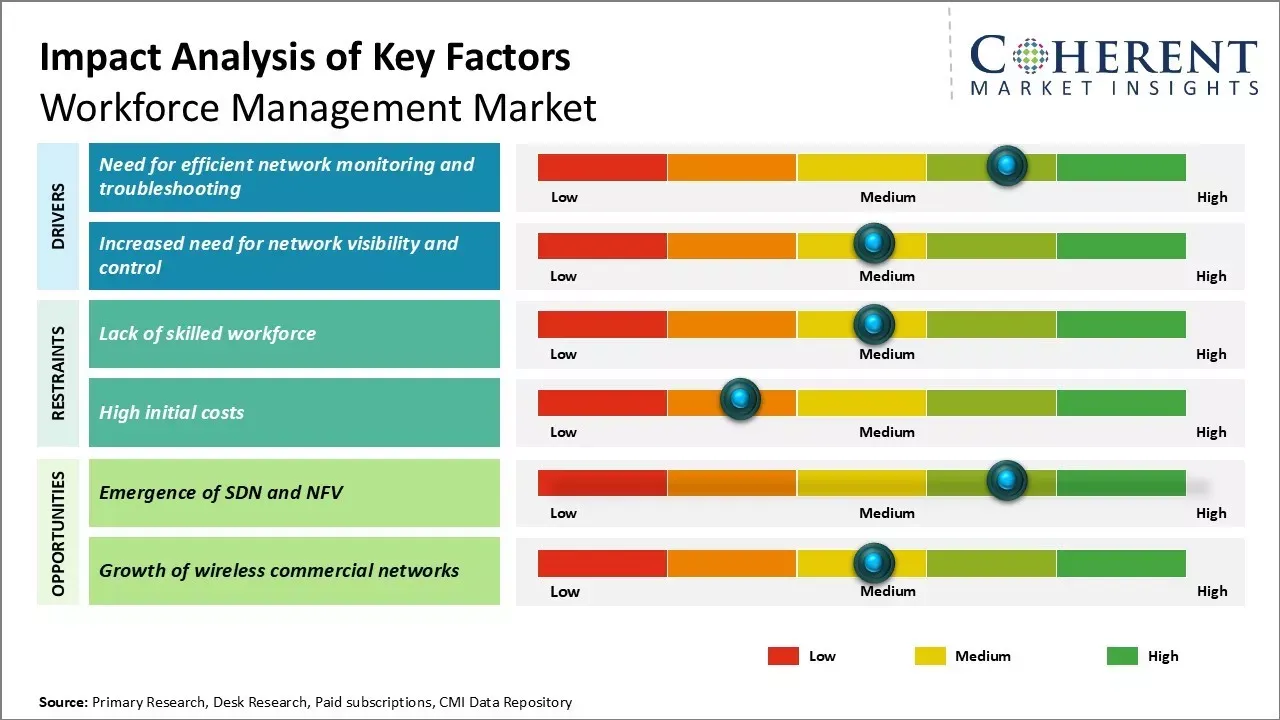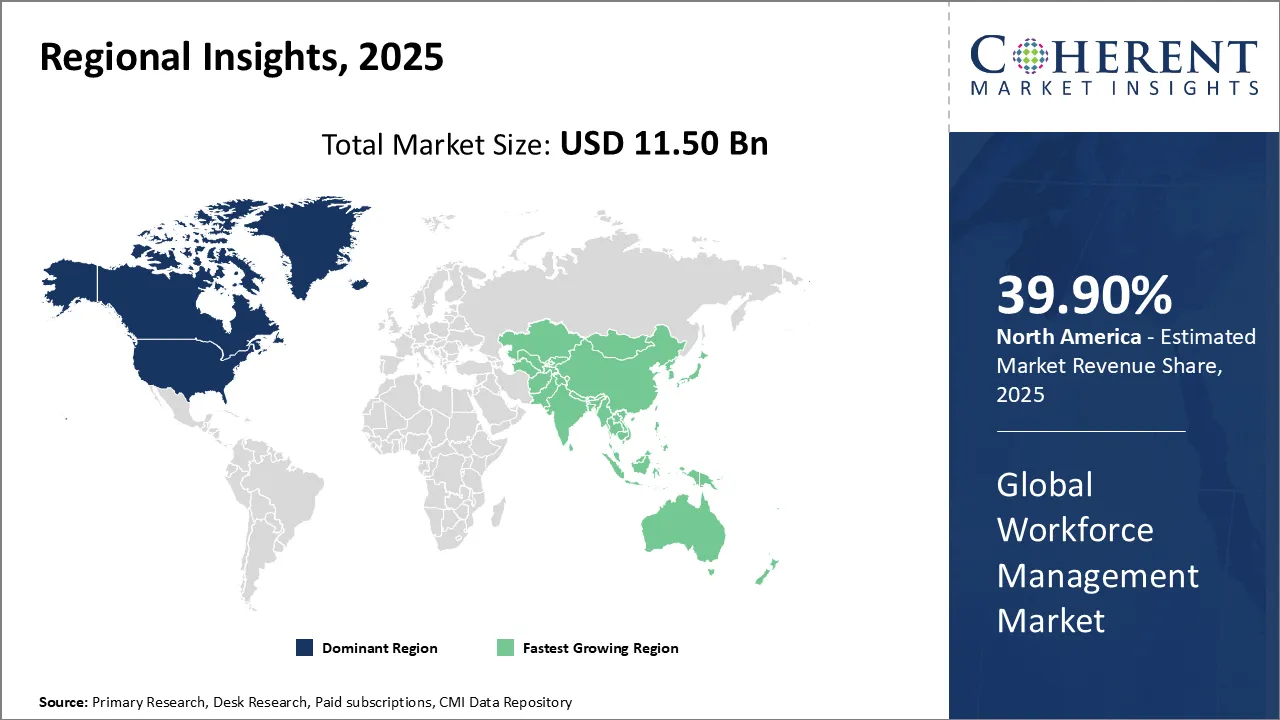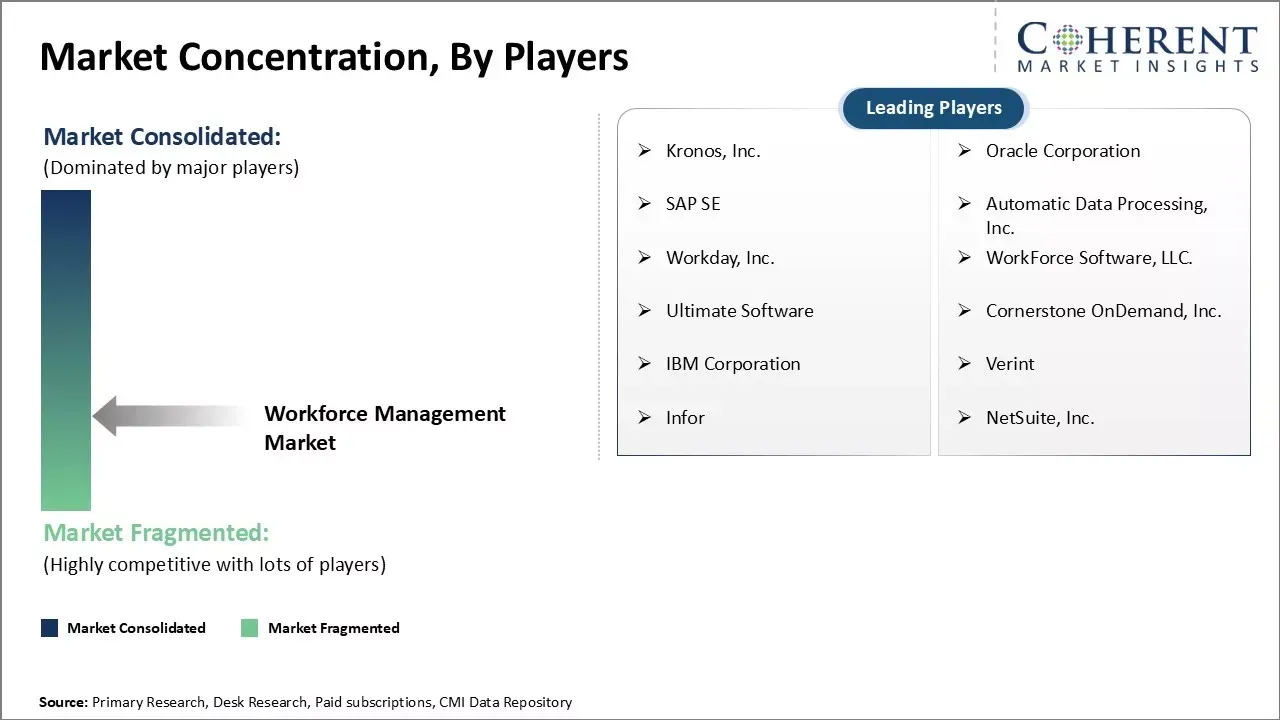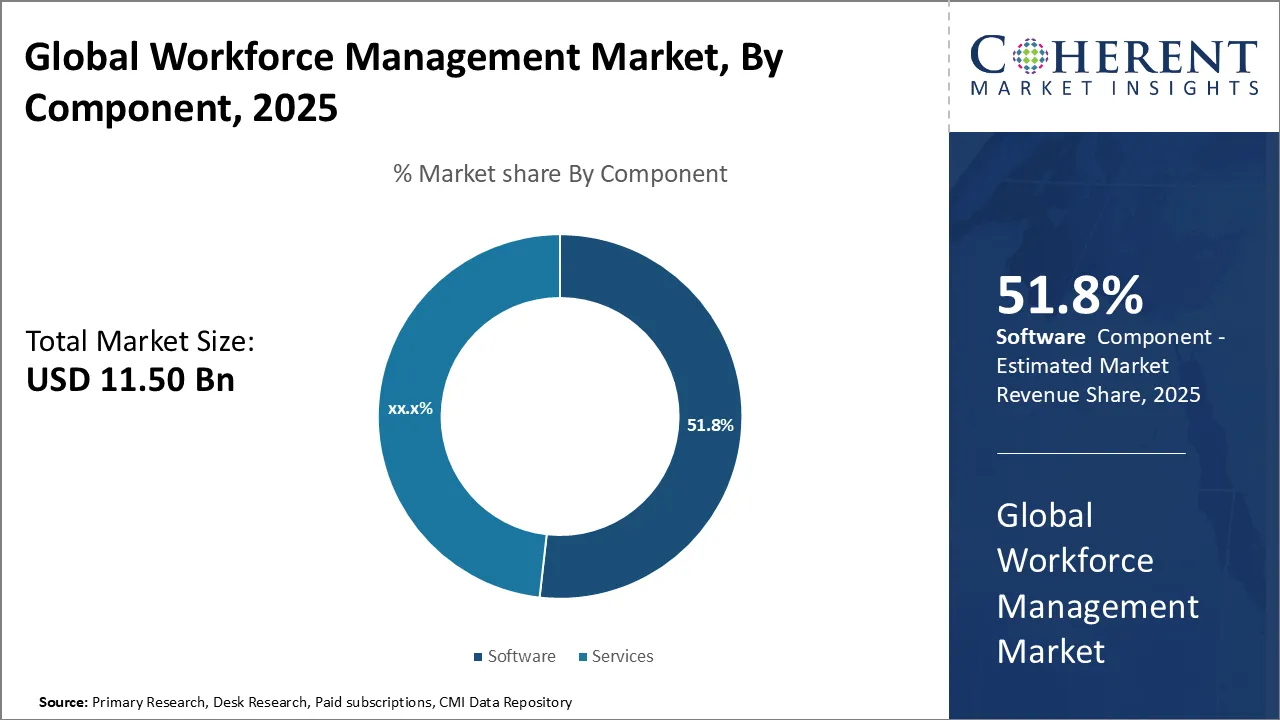Workforce Management Market Size and Trends - 2025 to 2032
Global workforce management market is estimated to be valued at USD 11.50 Bn in 2025 and is expected to reach USD 14.64 Bn by 2032, exhibiting a compound annual growth rate (CAGR) of 3.5% from 2025 to 2032.
Key Takeaways
- Based on Deployment, the Cloud-Based segment is expected to lead the market with largest share in 2025, offering scalability, cost savings, flexibility, and secure remote access.
- Based on End User, the BSFI segment is expected to hold 47.8% share of the market in 2025, fueled by digital service expansion and diverse staffing needs.
- Based on Component, the Software segment is projected to account for 51.8% share in 2025, driven by demand for highly customized enterprise solutions.
- Based on Application, the Workforce Analytics segment is projected to capture highest share of the market in 2025, driving predictive planning, efficiency, diversity, and smarter workforce management.
- Based on Region, North America is set to lead the workforce management market with 39.9% share in 2025. While, Asia Pacific is anticipated to be the fastest growing region.

To learn more about this report, Download Free Sample
Market Overview
Growing need among organizations to optimize productivity and streamline operations has encouraged the adoption of digital solutions. Adopting advanced workforce management solutions allows companies to efficiently schedule and plan employees, track attendance, time & attendance, and analyze absence patterns. This improves compliance with labor regulations and reduce operational costs. The growing adoption of cloud and mobile technologies is also supporting the demand for workforce management systems.
Current Events and Its Impacts on the Workforce Management Market
|
Current Event |
Description and its Impact |
|
AI and Automation Technology Integration |
|
|
Regulatory and Compliance Evolution |
|
Uncover macros and micros vetted on 75+ parameters: Get instant access to report
Role of Artificial Intelligence (AI) in Workforce Management Market
The market for Artificial Intelligence (AI) in workforce management is growing rapidly and is changing the way companies handle their workers. AI-powered platforms make scheduling, compliance, performance tracking, and employee engagement easier, which lowers administrative costs and boosts productivity. Predictive analytics assists with planning for staffing needs, and automation makes HR tasks easier. Healthcare, manufacturing, retail, BFSI, and IT are all using it around the world.
For instance, in July 2025, ShiftMed released its AI-powered Workforce Suite to assist healthcare facilities hire the right people. The platform takes care of scheduling, compliance, and workforce allocation automatically, which makes things easier for administrators and better for patients. It uses predictive analytics to predict staffing needs, improve flexibility, and give frontline healthcare workers the tools they need to engage with patients more effectively. This helps solve problems with staffing shortages and operational issues across the board.
Workforce Management Market Insights, By Deployment - Cloud-Based Due To Scalability, Cost Efficiency, And Remote Accessibility
In terms of deployment, the cloud-based segment is expected to lead the market with the largest share in 2025, as it can grow with their needs, is cost-effective, and supports remote work. Companies like the cloud for real-time analytics, easier integration, and automated compliance. It makes things more flexible, brings down on IT costs, and makes sure that access is safe across different locations. This is why it will be the most popular deployment model in 2025.
For instance, in November 2025, ADP's release of a unified global workforce management suite demonstrates that growing numbers of people want cloud-based solutions. It provides scalability, real-time analytics, and secure access all over the world by connecting different HCM platforms. This new feature cuts down on IT costs, makes it easier for people to work from home, and gives ADP a stronger position in the cloud workforce management market.
Workforce Management Market Insights, By End User - Expanding Service Portfolios Drive BFSI Sector Demand
In terms of end user, the BFSI segment is expected to register 47.8% of the market share in 2025 due to its diverse and expanding service offerings. Traditionally relying on branch networks for distributions, BFSI firms now provide an extensive array of digital banking, lending, investment, and insurance services available anytime through online and mobile channels. This shift has expanded roles across customer support, financial advising, underwriting and more that must be efficiently staffed.
For instance, SBI is improving the way banks manage their employees by setting a goal of having 30% of their employees be women by 2030 and starting a leadership program. This program encourages diversity, talent development, and inclusion. It fits with modern workforce strategies in the BFSI sector that focus on employee engagement, succession planning, and cultural change.
Workforce Management Market Insights, By Component - Extensive Customization Requirements Drive Software Dominance
In terms of component, the software segment is expected to register 51.8% market share in 2025 due to organizations' needs for highly customized solutions. Off-the-shelf SaaS platforms often lack the flexibility required to model complex and unique business processes, organizational hierarchies, and compensation structures. Particularly for larger enterprises operating across multiple divisions and geographies, generic applications fail to account for the varied local compliance factors, working culture nuances and legacy systems environments.
For instance, in November 2025, UKG Beacon's launch and UKG Ready's new AI-powered features make software-driven workforce management even stronger. These tools are made for small and medium-sized businesses and make scheduling, time tracking, analytics, and employee engagement better. The new idea comes from the fact that more and more people want smart, scalable workforce management solutions that use advanced software and AI.
Workforce Management Market Insights, By Application - Workforce Analytics Is Vital for Predictive Planning, Real-Time Insights, And Optimized Workforce Efficiency
In terms of application, the workforce analytics segment is expected to lead the market with highest share in 2025, as companies shift from reactive reporting to predictive planning. It gives real-time insights, skills predictions, and geographic talent analysis, which leads to more efficiency, diversity, and savings. AI-powered analytics is a must-have tool for managing a workforce because it helps with hiring, scheduling, and keeping employees.
For instance, in October 2025, Mercer's release of AI-powered HR platforms improves workforce analytics for managing employees. These tools help companies become more efficient, diverse, and able to plan for the long term by giving them predictive insights, talent optimization, and data-driven decision-making. This new idea shows how much more advanced analytics are going to be needed to manage modern workforces well in 2025.
Regional Insights

To learn more about this report, Download Free Sample
North America Workforce Management Market Analysis & Trends
North America is the leading region with a projected growth of 39.9% in 2025. North America’s dominance in the workforce management market can be attributed to the well-established market ecosystem and increasing demand from large enterprises in the region. Furthermore, strategic investments by technology companies and favorable government policies supporting innovation have propelled adoption.
For instance, in October 2025, Dollar Tree has used Legion's workforce management solution in 9,000 stores and 18 distribution centers, which employ 150,000 people. The mobile app allows to schedule shifts, switch shifts, and communicate to each other, while automation makes it easier to follow the rules, make predictions, and budget for labor. This rollout across the entire chain improves efficiency, engagement, and operational visibility for the retail giant.
Asia Pacific Workforce Management Market Analysis & Trends
The Asia Pacific region exhibits the fastest growth due to the rapidly expanding economies, growing demand from emerging industries, and increasing focus on optimizing resource utilization. Countries like China and India are prioritizing workforce efficiency to boost productivity.
For instance, in December 2025, Star Link Communication Pvt. Ltd., based in New Delhi, India, has been a leader in biometric and workforce management solutions for 30 years. The company has improved efficiency, compliance, and productivity across industries by focusing on attendance systems, access control, and workforce software. This has strengthened its position as a trusted provider of workforce technology.
Workforce Management Market Outlook for Key Countries
The U.S. Workforce Management Market Trends
The U.S. workforce management market continues to grow steadily with technological advancements and established vendors expanding capabilities to address evolving business needs. Major players like Kronos and ADP hold a firm presence. Companies like Kronos and BambooHR are focusing on scalable cloud-based platforms to address workforce planning, especially for remote and hybrid setups.
For instance, in December 2025, Mercans launched the world's first AI-powered engine for managing leave for a globally intelligent workforce. The platform makes sure that all 160 countries are following the rules, makes it easier for employees to take time off, and cuts down on administrative work. It makes the workforce more efficient by combining real-time rules, providing predictive analytics, and making sure that companies can easily manage a wide range of global leave policies.
China Workforce Management Market Trends
China’s market is witnessing a substantial growth on the back of government initiatives promoting digitization and workplace reforms. Rising multinational center expansions have also increased solution deployments. Companies like Huawei and Haier are leveraging workforce management software to optimize labor productivity in smart factories, integrating IoT and AI tools.
For instance, in July 2025, China started a program to train 30 million workers in vocational skills by 2027. The program assists with demographic problems, makes industries more competitive, and helps advanced fields like manufacturing, AI, and healthcare. Foreign-invested businesses benefit from a more skilled workforce, which helps the country reach its modernization goals.
India Workforce Management Market Trends
India continues to lead among emerging markets attributed to the government's 'Digital India' campaign and widespread adoption among IT/ITeS firms for capacity management. Leading vendors catering to these sectors include Zoho and OrangeHRM. Major IT companies like TCS, Infosys, and Wipro use AI-driven tools to manage large-scale workforce scheduling, remote work, and project allocation.
For instance, in October 2025, Hunar AI started India's first self-service voice AI solutions for engaging frontline workers. Employees can use voice commands to get to their schedules, leave, and HR policies on the platform. It makes communication better, minimizes on administrative costs, and gives workers in industries like retail, manufacturing, logistics, and healthcare the power to use self-service tools effectively.
The U.K. Workforce Management Market Trends
The market outlook remains positive in the U.K. with the increasing need to optimize operational costs and worker productivity impacting industries like manufacturing and retail. Players like SAP SuccessFactors and Workday have a prominent presence. Companies like PwC and Unilever are implementing flexible workforce management systems to support hybrid work environments, enabling seamless transitions between remote and office work.
For instance, in December 2025, Mercans released the first AI-powered global Workforce & Leave Management Engine in the world. It makes compliance easier by turning raw data about time, attendance, and leave into payroll-ready transactions in different countries. The solution brings together rules for the workforce, cuts down on the need for manual changes, makes sure that audits can be done, and makes multinational companies with diverse teams more efficient.
Market Concentration and Competitive Landscape

To learn more about this report, Download Free Sample
Market Report Scope
Workforce Management Market Report Coverage
| Report Coverage | Details | ||
|---|---|---|---|
| Base Year: | 2024 | Market Size in 2025: | USD 11.50 Bn |
| Historical Data for: | 2020 To 2024 | Forecast Period: | 2025 To 2032 |
| Forecast Period 2025 to 2032 CAGR: | 3.5% | 2032 Value Projection: | USD 14.64 Bn |
| Geographies covered: |
|
||
| Segments covered: |
|
||
| Companies covered: |
Kronos, Inc., Oracle Corporation, SAP SE, Automatic Data Processing, Inc., Workday, Inc., WorkForce Software, LLC., Ultimate Software, Cornerstone OnDemand, Inc., IBM Corporation, Verint, Infor, and NetSuite, Inc. |
||
| Growth Drivers: |
|
||
| Restraints & Challenges: |
|
||
Uncover macros and micros vetted on 75+ parameters: Get instant access to report
Workforce Management Market Driver
Need for Efficient Network Monitoring and Troubleshooting
The need for efficient network monitoring and troubleshooting is increasingly critical in the workforce management market, particularly as remote and hybrid work models rely heavily on seamless digital communication. For instance, in the IT services sector, a company like Infosys has implemented network monitoring tools to identify and resolve connectivity issues swiftly, ensuring uninterrupted access to workforce management platforms. This improves employee productivity, minimizes downtime, and supports real-time performance tracking across distributed teams, highlighting the growing reliance on robust network solutions.
Workforce Management Market Opportunity
Emergence of SDN and NFV
The emergence of Software-Defined Networking (SDN) and Network Function Virtualization (NFV) is unveiling new opportunities in the workforce management market by enabling scalable and efficient network infrastructures. For instance, a global retail chain adopted SDN to optimize connectivity across its outlets, ensuring seamless access to centralized workforce management systems. By leveraging NFV, the company virtualized network functions, reducing dependency on hardware and enabling real-time workforce scheduling and analytics. This technological shift supports rapid scalability, enhancing workforce productivity and operational agility across distributed locations.
Emerging Startups in the Workforce Management Market
Innovative Technologies - Klokkin develops AI-powered virtual assistants for automated staff scheduling. Shiftboard offers a mobile platform leveraging geo-location to optimize real-time staff movements. Such advanced solutions will reshape how businesses manage hourly workforces.
Sustainability - Companies like Circl promote green initiatives through paperless time-tracking and digital paystubs. This helps reduce carbon footprint. Rezku uses Blockchain to create transparent global labor markets, ensuring ethical recruitment. Such emerging models can drive major environmental and social impact.
Niche Segments - Startups complement big vendors by addressing niche segments. Deputy caters to small businesses and simplifies time tracking on any device. Deputy's partnerships with POS providers extend its reach. Signify focuses on healthcare facilities through customizable shift templates.
Analyst Opinion (Expert Opinion)
There is strong structural demand in the workforce management market, which is backed by measurable pressure on labor costs, compliance requirements, and the growing complexity of the workforce across industries. Market estimates differ greatly as they look at different things. For example, some analyses only look at core software modules, while others include services, hardware, and related workforce analytics capabilities. Even though there are differences, the underlying indicators of adoption stay the same.
Time and attendance, scheduling, and absence management remain the most common types of deployments, especially for businesses with hourly and multi-shift workers. Manufacturing, retail, logistics, healthcare, and contact-center operations make up a large part of active implementations because they are directly affected by staffing problems and extra costs. Companies are looking for data-backed staffing decisions, so workforce analytics and optimization tools, like predictive scheduling and skills-based deployment, are growing quickly from a small base.
In core segments, vendor concentration is relatively high, with largest platform providers controlling most enterprise-scale deployments. Ongoing consolidation, platform integration, and product portfolio rationalization are changing the way companies compete. Most new contracts use cloud-based delivery, which lets you deploy things faster, make money on a regular basis, and add new features all the time.
AI-driven automation is moving from the testing stage to having a real effect on business, making predictions more accurate, sticking to schedules, and getting payroll right. But integrating with old HR and payroll systems continues to remain a major barrier to adoption, and it often takes longer to implement. Overall, workforce management is becoming more of a strategic operational tool than an administrative system, with measurable results in terms of productivity and cost-effectiveness.
Recent Developments
- In June 2025, Deloitte started offering extended workforce solutions to change the way companies manage temporary workers. The platform makes it easier for contractors, freelancers, and gig workers to find work, get started, stay compliant, and do a good job. It improves visibility, lowers risks, and includes temporary workers in strategic workforce planning with AI-driven insights. This lets businesses cut costs and become more flexible around the world.
- In July 2025, ServiceNow added Agentic Workforce Management to its AI agent orchestration platform. The solution brings together human workers and AI agents, automating scheduling, assigning tasks, and planning the workforce. It makes large, distributed global businesses more efficient, cuts down on manual work, and makes the work experience better for employees by giving them real-time visibility and predictive analytics.
Market Segmentation
- By Deployment Insights (Revenue, USD Bn, 2025 - 2032)
- On-Premise
- Cloud
- By End User Insights (Revenue, USD Bn, 2025 - 2032)
- BFSI
- Media and Entertainment
- Retail and E-commerce
- IT and Telecom
- Government
- Healthcare
- Transportation and Logistics
- Others
- By Component Insights (Revenue, USD Bn, 2025 - 2032)
- Software
- Services
- By Application Insights (Revenue, USD Bn, 2025 - 2032)
- Workforce Analytics
- Workforce Scheduling
- Time and Attendance Management
- Others
- Regional Insights (Revenue, USD Bn, 2025 - 2032)
- North America
- U.S.
- Canada
- Latin America
- Brazil
- Argentina
- Mexico
- Rest of Latin America
- Europe
- Germany
- U.K.
- Spain
- France
- Italy
- Russia
- Rest of Europe
- Asia Pacific
- China
- India
- Japan
- Australia
- South Korea
- ASEAN
- Rest of Asia Pacific
- Middle East
- GCC Countries
- Israel
- Rest of Middle East
- Africa
- South Africa
- North Africa
- Central Africa
- Key Players Insights
- Kronos, Inc.
- Oracle Corporation
- SAP SE
- Automatic Data Processing, Inc.
- Workday, Inc.
- WorkForce Software, LLC.
- Ultimate Software
- Cornerstone OnDemand, Inc.
- IBM Corporation
- Verint
- Infor
- NetSuite, Inc.
Sources
Primary Research Interviews
- Workforce Management Software Vendors
- HR Technology Solution Providers
- Payroll & Time Tracking Service Providers
- Enterprise HR Managers & Operations Heads
- Workforce Analytics & Consulting Firms
- Others
Databases
- Bloomberg Terminal
- Factiva
- Hoovers Database
- Others
Magazines
- HR Magazine
- Workforce Management Magazine
- Human Resource Executive
- HR Tech Outlook
- People Management Magazine
- Others
Journals
- International Journal of Human Resource Management
- Human Resource Management Journal
- Journal of Workforce Analytics
- Academy of Management Journal
- Employee Relations Journal
- Others
Newspapers
- Financial Times
- The Wall Street Journal
- Reuters
- Bloomberg News
- The Economic Times
- Others
Associations
- Society for Human Resource Management (SHRM)
- WorldatWork Association
- Chartered Institute of Personnel and Development (CIPD)
- International Association for Human Resource Information Management (IHRIM)
- HR Technology Conference & Expo
- Others
Public Domain Sources
- U.S. Bureau of Labor Statistics (BLS)
- International Labour Organization (ILO)
- World Economic Forum (WEF)
- OECD Labour Market Statistics
- Eurostat
- Others
Proprietary Elements
- CMI Data Analytics Tool
- Proprietary CMI Existing Repository of Information for the Last 8 Years
Share
Share
About Author
Suraj Bhanudas Jagtap is a seasoned Senior Management Consultant with over 7 years of experience. He has served Fortune 500 companies and startups, helping clients with cross broader expansion and market entry access strategies. He has played significant role in offering strategic viewpoints and actionable insights for various client’s projects including demand analysis, and competitive analysis, identifying right channel partner among others.
Missing comfort of reading report in your local language? Find your preferred language :
Transform your Strategy with Exclusive Trending Reports :
Frequently Asked Questions
EXISTING CLIENTELE
Joining thousands of companies around the world committed to making the Excellent Business Solutions.
View All Our Clients

